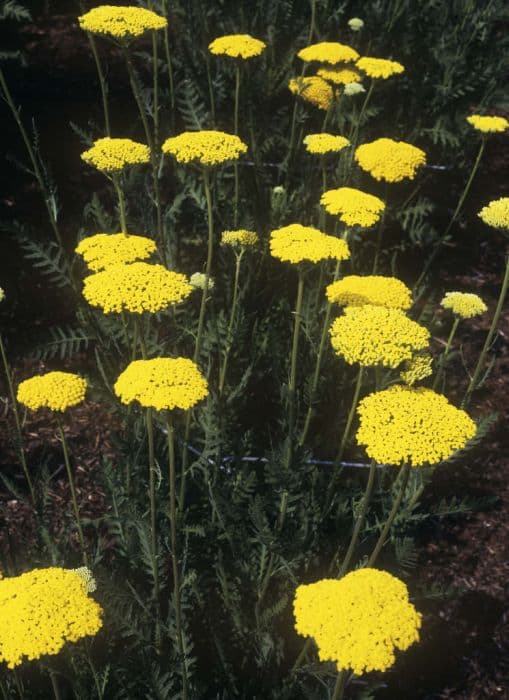Italian Aster Aster amellus 'Cotswold Gem'

ABOUT
The 'Cotswold Gem' is a striking variety of the Italian aster known for its ornamental qualities and vibrant blooms. This perennial showcases a lush mound of foliage, with leaves that are lance-shaped and a rich green in color, providing a dense backdrop for its flowers. Its most distinctive feature is the beautiful daisy-like blossoms which arrive in abundance. The blooms are a captivating lavender or violet, with a ring of slender, ray-like petals encircling a golden-yellow central disk. These vivid flowers create a charming contrast against the foliage and are known to attract butterflies and other pollinators. The Italian aster as a whole is admired for its robust habit and the lengthy period during which it graces gardens with color, often from late summer into the fall, extending the season of visual interest in the landscape.
About this plant
 Names
NamesSynonyms
Italian Aster, European Michaelmas Daisy
Common names
Aster amellus 'Cotswold Gem'
 Toxicity
ToxicityTo humans
The common name for Aster amellus 'Cotswold Gem' is Italian aster. Generally, Italian asters are not considered toxic to humans. There is no widespread documentation of their ingestion leading to poisoning or serious health consequences. However, as with any plant material, individuals could possibly experience mild gastrointestinal discomfort if ingested in large quantities or if the individual has a sensitivity or allergic reaction to the plant.
To pets
The Italian aster is not typically known to be toxic to pets. It is not listed among the plants that are poisonous to cats, dogs, or other domestic animals. However, pets may still experience mild stomach upset if they consume this plant, particularly if they are not used to eating vegetation or in large amounts. Monitoring your pet for any signs of distress after ingestion of any plant material is always a good precaution.
 Characteristics
CharacteristicsLife cycle
Perennials
Foliage type
Deciduous
Color of leaves
Green
Flower color
Lavender
Height
1-2 feet (30-60 cm)
Spread
1-2 feet (30-60 cm)
Plant type
Herb
Hardiness zones
4
Native area
Europe
Benefits
 General Benefits
General Benefits- Attracts Pollinators: Aster amellus 'Cotswold Gem' is known to attract bees, butterflies, and other pollinating insects, supporting local ecosystems.
- Drought Tolerant: Once established, this plant has a good tolerance for dry conditions, requiring minimal watering.
- Low Maintenance: It requires little care beyond the basics, making it an easy choice for gardeners of all skill levels.
- Long Flowering Period: The plant has a lengthy blooming season, providing color in the garden from late summer into autumn.
- Aesthetic Appeal: With its lovely lavender-blue flowers and neat mounded habit, it adds visual interest to borders, beds, and containers.
- Hardy Nature: It is resilient to many pests and diseases, and can withstand cooler temperatures of temperate climates.
- Wildlife Friendly: Besides attracting pollinators, it can also provide a food source for birds when the flowers turn to seed.
- Easy to Propagate: It can be easily propagated by seed, division, or cuttings, allowing gardeners to expand their collection or share with others.
- Versatility in Landscaping: Suitable for rock gardens, traditional flower beds, and as part of a perennial border.
 Medical Properties
Medical PropertiesThis plant is not used for medical purposes.
 Air-purifying Qualities
Air-purifying QualitiesThis plant is not specifically known for air purifying qualities.
 Other Uses
Other Uses- Aster amellus 'Cotswold Gem', commonly known as Italian Aster, can be used in floral arrangements, particularly for informal events or cottage-style bouquets.
- The vibrant blooms of Italian Aster may be pressed and included in homemade greeting cards or bookmarks as a decorative element.
- The plant's ability to attract beneficial insects like bees can be utilized in companion planting to improve the pollination of vegetable gardens and fruit orchards.
- Italian Aster flowers could be used to create a natural dye for textiles, giving a delicate color to fabrics.
- The dried petals of Italian Aster could be incorporated into potpourri mixes to take advantage of its aesthetic appeal in dry form.
- Italian Aster can be a photographic subject for nature photographers due to its striking blooms and visual appeal in a natural setting.
- The plant might be used in educational settings such as schools or nature centers to teach about the lifecycle of plants and the importance of pollinators.
- Italian Aster can be used in sensory gardens, as their texture and color provide visual stimulation and attract wildlife, enhancing the sensory experience.
- Landscapes designed for wildlife or to promote biodiversity can include Italian Aster as it provides nectar for a range of insects.
- Italian Aster serves as a natural indicator of the changing seasons, with its blooming patterns signaling the arrival of late summer and early autumn.
Interesting Facts
 Feng Shui
Feng ShuiThe Italian aster is not used in Feng Shui practice.
 Zodiac Sign Compitability
Zodiac Sign CompitabilityThe Italian aster is not used in astrology practice.
 Plant Symbolism
Plant Symbolism- Love and Devotion: The Aster amellus 'Cotswold Gem', commonly known as the Italian Aster, often symbolizes love and devotion. Its dainty petals and star-like appearance have been associated with the deep and enduring qualities of love.
- Wisdom: This plant can also represent wisdom. In flower symbolism, many plants with a star-shaped figure, like the Italian Aster, are connected with wisdom and the pursuit of knowledge.
- Elegance and Patience: With its lush, textured blooms and refined presence in the garden, the Italian Aster is also symbolic of elegance. The plant’s gradual blooming process signifies patience and the unfolding of beauty over time.
- Remembrance: Asters have historically been used to symbolize remembrance, making the Italian Aster a flower that can be used to honor memories and the past, especially in moments of reflection or on special anniversaries.
- New Beginnings: The Italian Aster blooms in late summer and fall, which are times of transition in the seasonal calendar. Therefore, it often represents new beginnings, heralding the change of seasons and the start of a new cycle.
 Water
WaterThe Italian Aster should be watered regularly, aiming to keep the soil consistently moist without being soggy. During the active growing season in spring and summer, it might require watering approximately once a week, depending on the climate and weather conditions. It’s essential to reduce watering frequency in the fall and even more so in winter, when the plant is dormant. When you water, gently soak the soil with water, using about 1 to 2 gallons per watering session, allowing the water to penetrate deeply into the root zone. Adjust watering based on rainfall and check the soil moisture before watering to prevent overwatering.
 Light
LightItalian Aster thrives in full sun to partial shade. The ideal spot for this plant is in an area where it receives at least 6 hours of direct sunlight daily, but it can also perform well with some light afternoon shade. Avoid deeply shaded areas as this can detract from its flowering performance and overall health.
 Temperature
TemperatureItalian Aster prefers a temperate climate and is quite hardy, withstanding short-term temperature fluctuations. It can survive in temperatures as low as 20°F and as high as 80°F. However, the ideal temperature range for optimal growth is between 60°F and 75°F. Ensure protection from extreme cold, as prolonged exposure to temperatures below the minimum can damage or kill the plant.
 Pruning
PruningPruning the Italian Aster is essential to maintain its shape, encourage bushier growth, and enhance blooming. Prune in early spring by cutting back the previous year's growth to about 6 inches above the ground. Additionally, deadhead spent blooms throughout the blooming season to promote further flowering. Pruning is best done annually for the health and aesthetics of the plant.
 Cleaning
CleaningAs needed
 Soil
SoilThe Italian Aster (Aster amellus 'Cotswold Gem') prefers well-draining, loamy soil with a pH between 6.0 and 7.0. For the best growth, mix garden soil with compost and a bit of sand to improve drainage. Avoid soil that retains too much water, as this can lead to root rot.
 Repotting
RepottingItalian Aster should generally be repotted every two to three years or when it outgrows its current container. Repotting provides fresh nutrients and room for expanding roots, ensuring continued healthy growth.
 Humidity & Misting
Humidity & MistingItalian Aster performs well in average outdoor humidity conditions. It does not require high humidity levels; normal outdoor ambient humidity is typically sufficient for this plant's growth and health.
 Suitable locations
Suitable locationsIndoor
Use bright, indirect light and well-draining soil.
Outdoor
Plant in full sun, well-drained soil, divide every 2-3 years.
Hardiness zone
4-8 USDA.
 Life cycle
Life cycleAster amellus 'Cotswold Gem', commonly known as Italian Aster, begins its life cycle as a seed which germinates usually in spring, requiring well-drained soil and moderate temperatures. Upon sprouting, the seedling establishes itself and progresses to a vegetative stage, developing a rosette of leaves while simultaneously growing its root system. During its growth phase, Italian Aster requires ample sunlight and adequate water to mature into a flowering plant. In late summer to early autumn, the plant produces daisy-like flowers with blue, violet, or lavender petals surrounding a yellow center, attracting pollinators and facilitating cross-pollination. After flowering, the Italian Aster sets seeds which disperse into the surrounding area, ensuring the propagation of new plants for the next season. As a perennial, the plant then enters a period of dormancy during the winter months, with its foliage dying back, to re-emerge the following spring from its hardy rootstock.
 Propogation
PropogationPropogation time
Late summer
The Italian Aster, also known as Aster amellus 'Cotswold Gem', can be propagated by division. This is typically done in either spring or early fall. To propagate by division, carefully lift the clump of the Italian Aster from the soil. Use a sharp spade or knife to separate the clump into smaller sections, ensuring that each new section has a good amount of roots and at least a few shoots. Replant the divisions into well-draining soil, spacing them about 12 inches (approximately 30 centimeters) apart to allow room for growth. Water the newly planted divisions regularly until they are well established. Division helps to rejuvenate older plants and provides a simple way to increase the number of plants in your garden.









